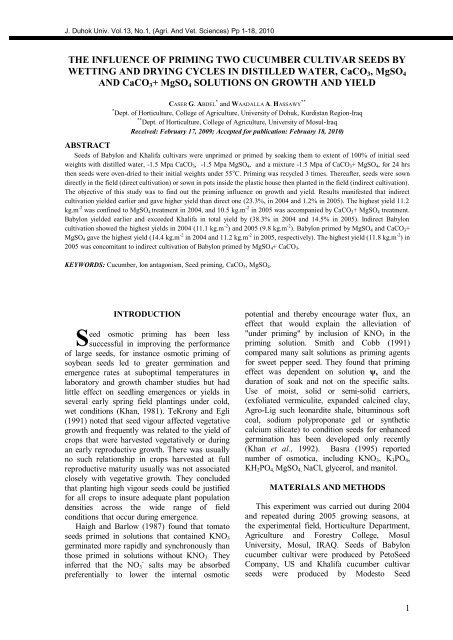The Influence Of Priming Two Cucumber Cultivar Seeds
The Influence Of Priming Two Cucumber Cultivar Seeds
The Influence Of Priming Two Cucumber Cultivar Seeds
Create successful ePaper yourself
Turn your PDF publications into a flip-book with our unique Google optimized e-Paper software.
J. Duhok Univ. Vol.13, No.1, (Agri. And Vet. Sciences) Pp 1-18, 2010<br />
THE INFLUENCE OF PRIMING TWO CUCUMBER CULTIVAR SEEDS BY<br />
WETTING AND DRYING CYCLES IN DISTILLED WATER, CaCO3, MgSO4<br />
AND CaCO3+ MgSO4 SOLUTIONS ON GROWTH AND YIELD<br />
CASER G. ABDEL * and WAADALLA A. HASSAWY **<br />
* Dept. of Horticulture, College of Agriculture, University of Dohuk, Kurdistan Region-Iraq<br />
** Dept. of Horticulture, College of Agriculture, University of Mosul-Iraq<br />
Received: February 17, 2009; Accepted for publication: February 18, 2010)<br />
ABSTRACT<br />
<strong>Seeds</strong> of Babylon and Khalifa cultivars were unprimed or primed by soaking them to extent of 100% of initial seed<br />
weights with distilled water, -1.5 Mpa CaCO3, -1.5 Mpa MgSO4, and a mixture -1.5 Mpa of CaCO3+ MgSO4, for 24 hrs<br />
then seeds were oven-dried to their initial weights under 55 o C. <strong>Priming</strong> was recycled 3 times. <strong>The</strong>reafter, seeds were sown<br />
directly in the field (direct cultivation) or sown in pots inside the plastic house then planted in the field (indirect cultivation).<br />
<strong>The</strong> objective of this study was to find out the priming influence on growth and yield. Results manifested that indirect<br />
cultivation yielded earlier and gave higher yield than direct one (23.3%, in 2004 and 1.2% in 2005). <strong>The</strong> highest yield 11.2<br />
kg.m -2 was confined to MgSO4 treatment in 2004, and 10.5 kg.m -2 in 2005 was accompanied by CaCO3+ MgSO4 treatment.<br />
Babylon yielded earlier and exceeded Khalifa in total yield by (38.3% in 2004 and 14.5% in 2005). Indirect Babylon<br />
cultivation showed the highest yields in 2004 (11.1 kg.m -2 ) and 2005 (9.8 kg.m -2 ). Babylon primed by MgSO4 and CaCO3+<br />
MgSO4 gave the highest yield (14.4 kg.m -2 in 2004 and 11.2 kg.m -2 in 2005, respectively). <strong>The</strong> highest yield (11.8 kg.m -2 ) in<br />
2005 was concomitant to indirect cultivation of Babylon primed by MgSO4+ CaCO3.<br />
KEYWORDS: <strong>Cucumber</strong>, Ion antagonism, Seed priming, CaCO3, MgSO4.<br />
S<br />
INTRODUCTION<br />
eed osmotic priming has been less<br />
successful in improving the performance<br />
of large seeds, for instance osmotic priming of<br />
soybean seeds led to greater germination and<br />
emergence rates at suboptimal temperatures in<br />
laboratory and growth chamber studies but had<br />
little effect on seedling emergences or yields in<br />
several early spring field plantings under cold,<br />
wet conditions (Khan, 1981). TeKrony and Egli<br />
(1991) noted that seed vigour affected vegetative<br />
growth and frequently was related to the yield of<br />
crops that were harvested vegetatively or during<br />
an early reproductive growth. <strong>The</strong>re was usually<br />
no such relationship in crops harvested at full<br />
reproductive maturity usually was not associated<br />
closely with vegetative growth. <strong>The</strong>y concluded<br />
that planting high vigour seeds could be justified<br />
for all crops to insure adequate plant population<br />
densities across the wide range of field<br />
conditions that occur during emergence.<br />
Haigh and Barlow (1987) found that tomato<br />
seeds primed in solutions that contained KNO3<br />
germinated more rapidly and synchronously than<br />
those primed in solutions without KNO3. <strong>The</strong>y<br />
inferred that the NO3 - salts may be absorbed<br />
preferentially to lower the internal osmotic<br />
potential and thereby encourage water flux, an<br />
effect that would explain the alleviation of<br />
"under priming" by inclusion of KNO3 in the<br />
priming solution. Smith and Cobb (1991)<br />
compared many salt solutions as priming agents<br />
for sweet pepper seed. <strong>The</strong>y found that priming<br />
effect was dependent on solution ψs and the<br />
duration of soak and not on the specific salts.<br />
Use of moist, solid or semi-solid carriers,<br />
(exfoliated vermiculite, expanded calcined clay,<br />
Agro-Lig such leonardite shale, bituminous soft<br />
coal, sodium polyproponate gel or synthetic<br />
calcium silicate) to condition seeds for enhanced<br />
germination has been developed only recently<br />
(Khan et al., 1992). Basra (1995) reported<br />
number of osmotica, including KNO3, K3PO4,<br />
KH2PO4, MgSO4, NaCl, glycerol, and manitol.<br />
MATERIALS AND METHODS<br />
This experiment was carried out during 2004<br />
and repeated during 2005 growing seasons, at<br />
the experimental field, Horticulture Department,<br />
Agriculture and Forestry College, Mosul<br />
University, Mosul, IRAQ. <strong>Seeds</strong> of Babylon<br />
cucumber cultivar were produced by PetoSeed<br />
Company, US and Khalifa cucumber cultivar<br />
seeds were produced by Modesto Seed<br />
1



